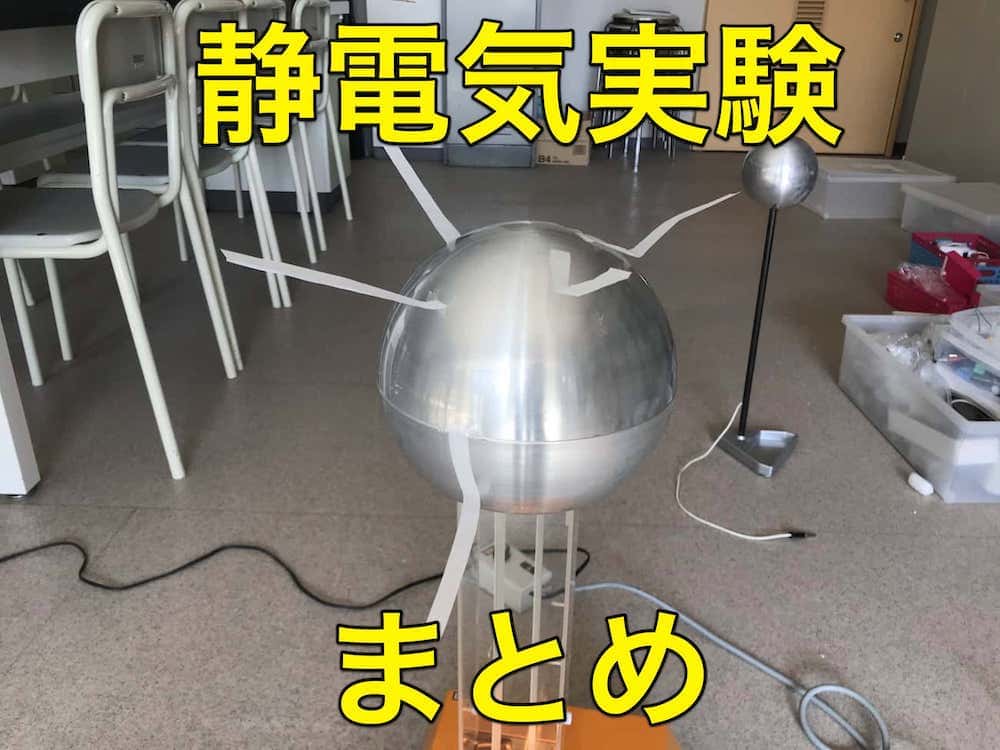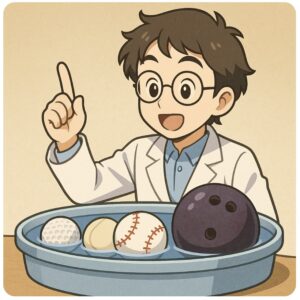Edo Magic: The Static Electricity Secret Behind a Japanese Scientist’s Self-Ringing Bell
I’m Ken Kuwako, Science Trainer. Every day is an experiment.
Recreating an Edo Period Electricity Experiment!
“Electricity in the Edo period?” You might be surprised! But even during the era of samurai and townspeople, there was actually a person who researched electricity! An experiment so strange it would shock a ninja, like magic or ninjutsu (ninja technique), where a bell rings all by itself. This time, we challenge ourselves to recreate this fascinating experiment documented by the Edo period scientist, Sokichi Hashimoto (Hashimoto Sokichi).
What is the “Art of Ringing a Bell Naturally”?
Sokichi Hashimoto was one of the scientists who studied Western science (called Rangaku, or Dutch learning) through the Netherlands, becoming fascinated with the technology of electricity, which was known as “Elekiter” at the time. His book, Oranda Shisei Elekiter Kyūrigen (The Origin of Elekiter, Dutch Style), describes several astonishing experiments using static electricity.One of these is the “Art of Ringing a Bell Naturally” (Shizen to Kane wo Narasu Jutsu). This device uses the power of static electricity to swing a metal ball like a pendulum, automatically ringing the two bells on either side, “clack-clack-clack.” Today, we call this a “static electric bell” or “electrostatic pendulum.” In fact, the principle is very similar to the “Franklin’s bell,” invented by the famous American scientist Benjamin Franklin to study lightning!For the people of the time, an object moving and making noise without anyone touching it must have been a truly mysterious sight. We used a modern tool, a Van de Graaff generator (static electricity generator), to recreate Mr. Hashimoto’s experiment.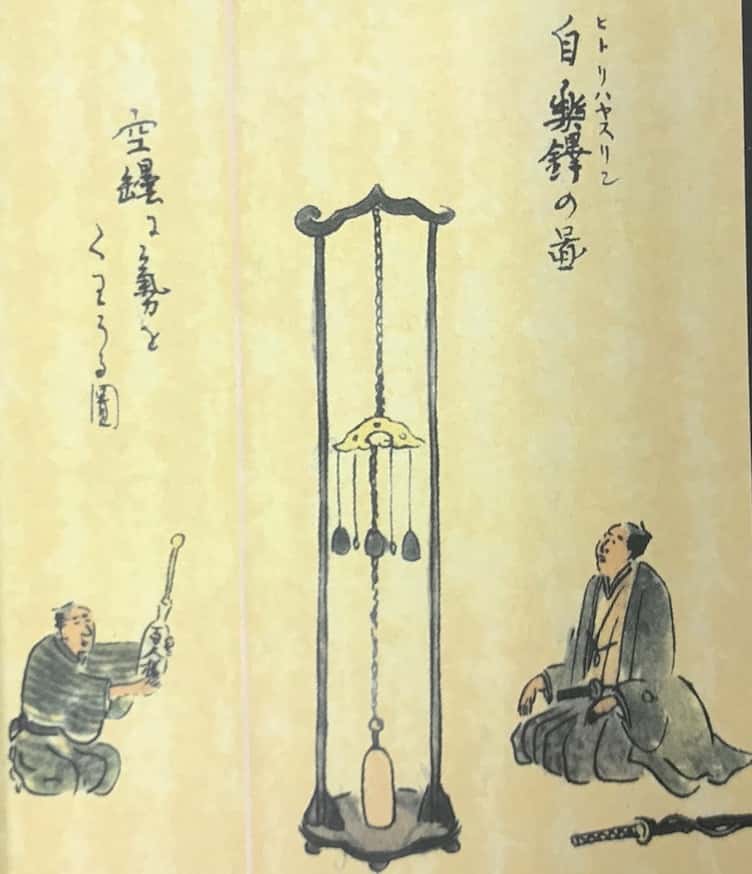
Diagram from Oranda Shisei Elekiter Kyūrigen by Sokichi Hashimoto, cited from Otona no Kagaku Magazine Vol. 22 (Gakken) P24, 25
When we built the setup, the metal ball swung back and forth, hitting the bells.https://youtu.be/tdfkSIh7pgI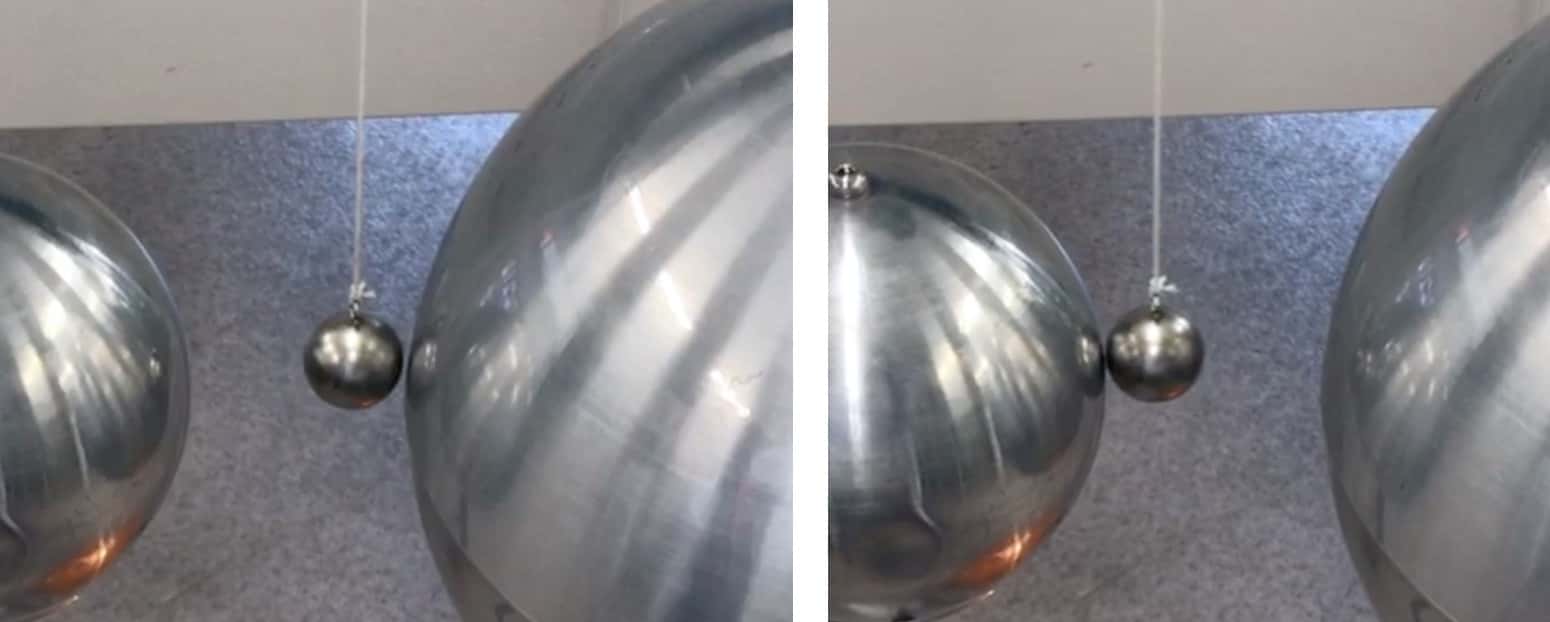 In the video, you can see a spark (discharge) occasionally, but the metal ball successfully swings back and forth, ringing the bells.
In the video, you can see a spark (discharge) occasionally, but the metal ball successfully swings back and forth, ringing the bells.
What is the Principle Behind It?
Why does the metal ball keep swinging automatically? The secret lies in the force of static electricity.First, let’s compare the properties of static electricity by bringing “Styrofoam” (which resists electricity) and a “ping pong ball wrapped in aluminum foil” (which conducts electricity) near the Van de Graaff generator.
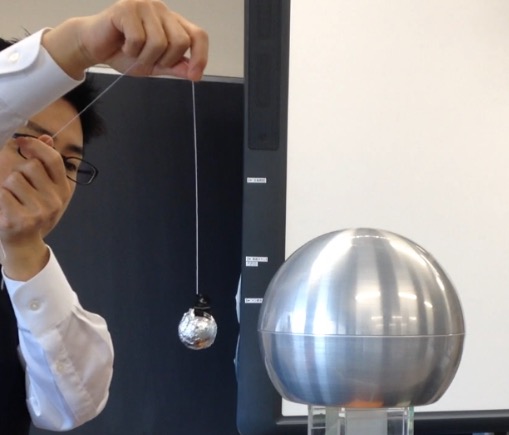
Watch the video below to see what happens.https://youtu.be/_OLDKBWBICUThe Styrofoam is attracted to the Van de Graaff and stays stuck to it. This is due to dielectric polarization. In a material that doesn’t easily conduct electricity (an insulator) like Styrofoam, the positive and negative charges slightly shift (polarize), causing the attraction. The electrical charge itself doesn’t move from one object to the other.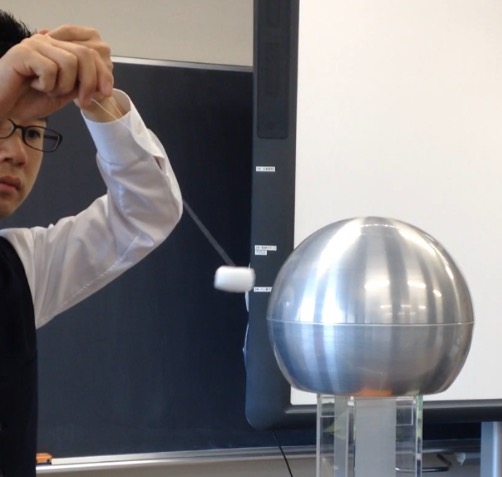 Now, what about the ping pong ball wrapped in aluminum foil? (Aluminum foil is a conductor, which easily carries electric charge.) When we bring it close to the Van de Graaff, it’s initially attracted…
Now, what about the ping pong ball wrapped in aluminum foil? (Aluminum foil is a conductor, which easily carries electric charge.) When we bring it close to the Van de Graaff, it’s initially attracted…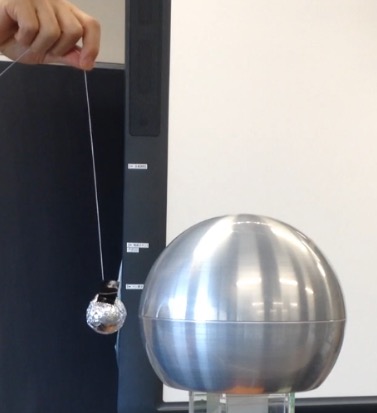 But the moment it touches the Van de Graaff, it’s strongly repelled and flies away!
But the moment it touches the Van de Graaff, it’s strongly repelled and flies away!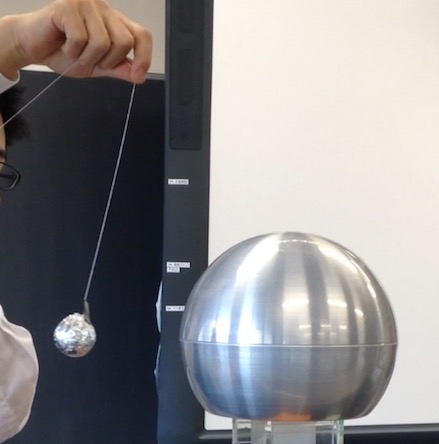 This is the key to our experiment: electrostatic induction and charge transfer. The motion of this ping pong ball is the exact principle of the static electric bell.
This is the key to our experiment: electrostatic induction and charge transfer. The motion of this ping pong ball is the exact principle of the static electric bell.
How the Static Electric Bell Keeps Ringing
Let’s look closely at the movement of electrons (negative charge), step by step!

Step 1: Attraction by Electrostatic InductionFirst, the large sphere of the Van de Graaff generator accumulates a large negative charge. This causes electrostatic induction in the hanging metal ball (pendulum). The electrons (negative charge) inside the metal ball are repelled by the negative charge of the Van de Graaff, moving to the farthest side (the left). As a result, the side closer to the Van de Graaff (the right) becomes positively charged. Since opposite charges attract, the metal ball is pulled toward the Van de Graaff on the right.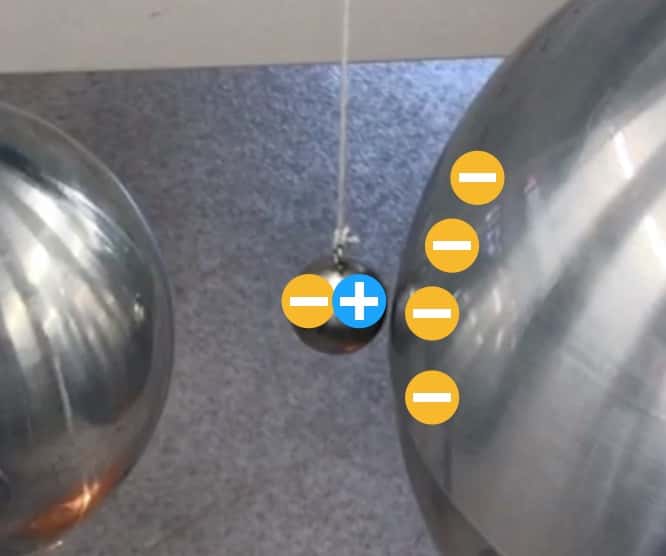 Step 2: Contact and Charge TransferNext, the metal ball hits the large sphere with a “clack!” The large negative charge accumulated on the Van de Graaff instantly flows into the metal ball.
Step 2: Contact and Charge TransferNext, the metal ball hits the large sphere with a “clack!” The large negative charge accumulated on the Van de Graaff instantly flows into the metal ball.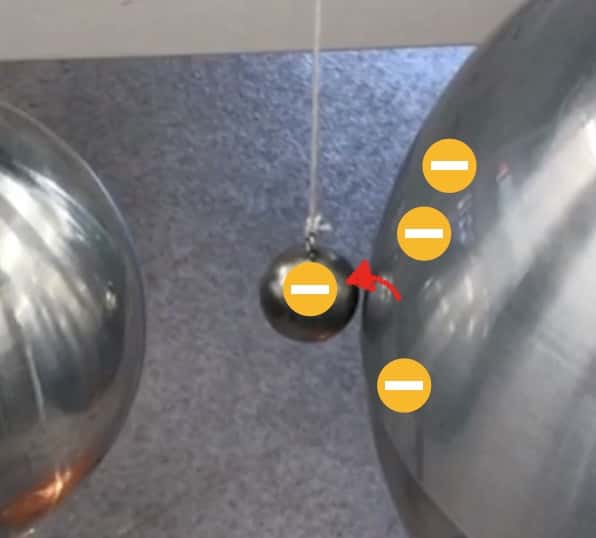 Step 3: Repulsion and Swing AwayNow negatively charged, the metal ball is repelled (repulsion force) by the large sphere (also negative). The metal ball is forcefully pushed to the left.
Step 3: Repulsion and Swing AwayNow negatively charged, the metal ball is repelled (repulsion force) by the large sphere (also negative). The metal ball is forcefully pushed to the left.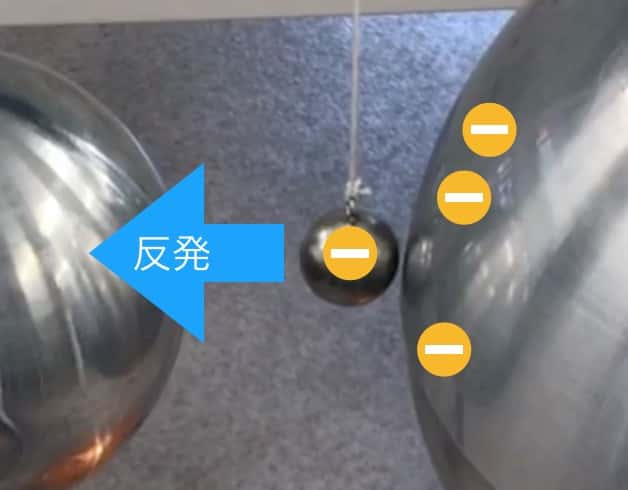 Step 4: Discharge via GroundThe ball hits the left-side sphere with another “clack!” This left sphere is grounded (connected to the earth), providing an escape route for the electrons (negative charge). The electrons accumulated on the metal ball flow away to the ground.
Step 4: Discharge via GroundThe ball hits the left-side sphere with another “clack!” This left sphere is grounded (connected to the earth), providing an escape route for the electrons (negative charge). The electrons accumulated on the metal ball flow away to the ground.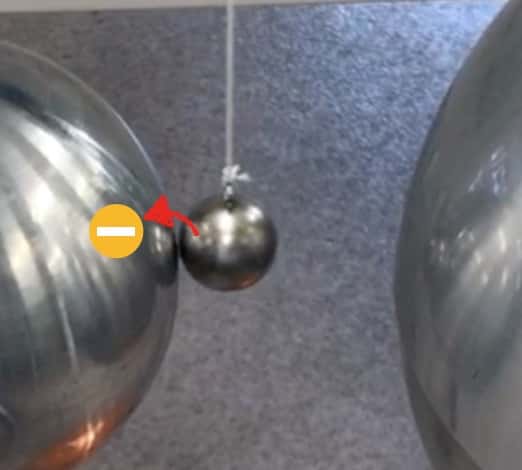 Step 5: Back to Step 1…Having lost its charge and returned to a neutral (zero charge) state, the metal ball once again undergoes electrostatic induction due to the negative charge of the Van de Graaff (Step 1), and is attracted back to the right.
Step 5: Back to Step 1…Having lost its charge and returned to a neutral (zero charge) state, the metal ball once again undergoes electrostatic induction due to the negative charge of the Van de Graaff (Step 1), and is attracted back to the right.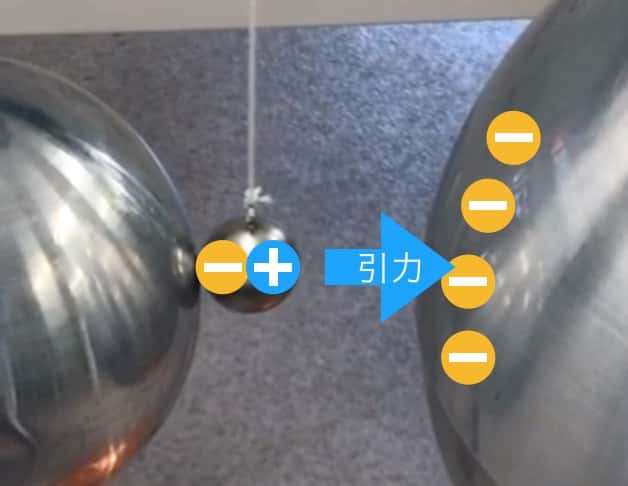 This process repeats: “Attracted $\rightarrow$ Receives Charge $\rightarrow$ Repelled $\rightarrow$ Discharges Charge $\rightarrow$ Attracted again…” The metal ball automatically swings back and forth, ringing the bells continuously.It’s amazing that the invisible movement of electrons creates such an interesting phenomenon! I’m sure Sokichi Hashimoto in the Edo period was thrilled while observing this, too.You can find information on how to build your own static electric bell here:https://phys-edu.net/wp/?p=49965
This process repeats: “Attracted $\rightarrow$ Receives Charge $\rightarrow$ Repelled $\rightarrow$ Discharges Charge $\rightarrow$ Attracted again…” The metal ball automatically swings back and forth, ringing the bells continuously.It’s amazing that the invisible movement of electrons creates such an interesting phenomenon! I’m sure Sokichi Hashimoto in the Edo period was thrilled while observing this, too.You can find information on how to build your own static electric bell here:https://phys-edu.net/wp/?p=49965
Fun Experiments with the Van de Graaff Generator!
We also share other exciting experiments using the Van de Graaff generator. Some of these were performed on TV with celebrities like Suzu Hirose, Ryohei Suzuki, Yasuko, and Chocolate Planet’s Osada and Matsuo. Find out more here.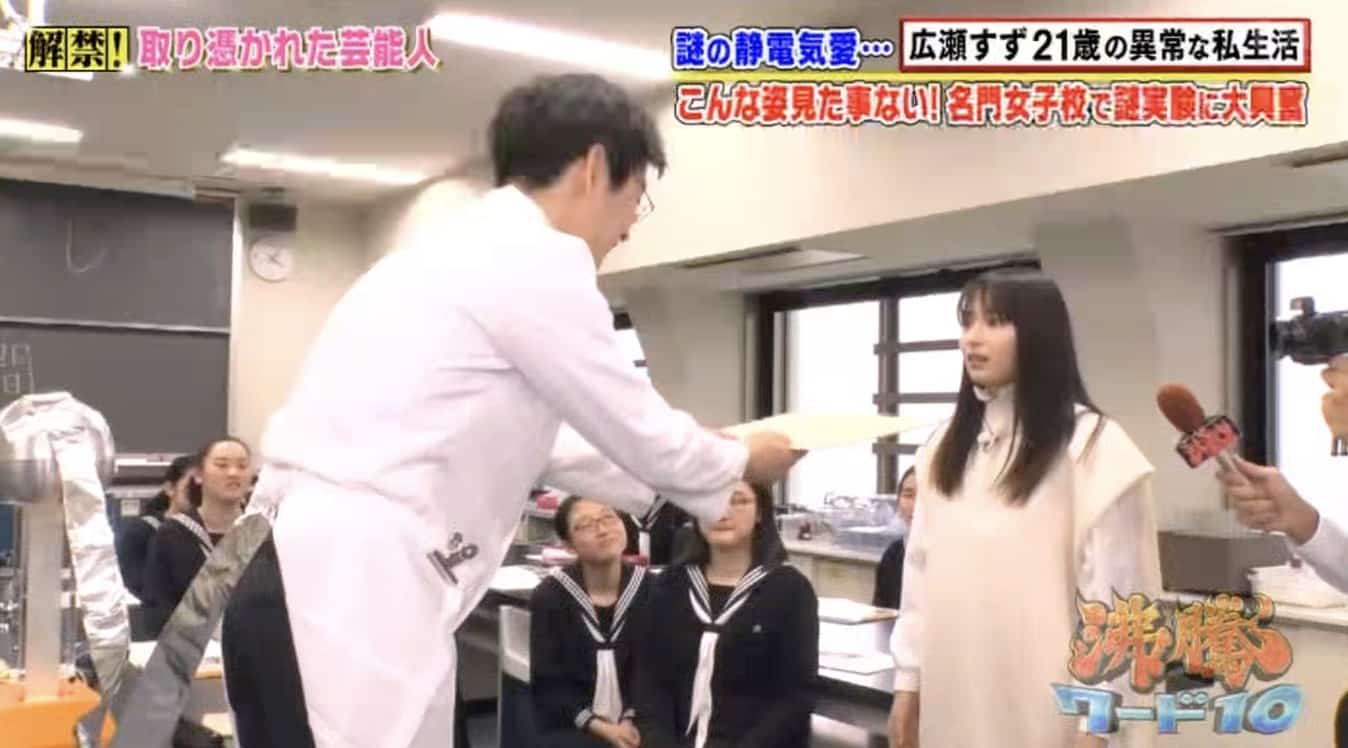 ※ Please note that any experiments using a Van de Graaff generator must be conducted under the supervision of a specialist. Please be careful if you attempt this. If you have any requests for static electricity experiments (workshops, TV supervision/appearances, etc.), please contact us here.
※ Please note that any experiments using a Van de Graaff generator must be conducted under the supervision of a specialist. Please be careful if you attempt this. If you have any requests for static electricity experiments (workshops, TV supervision/appearances, etc.), please contact us here.
【Special Feature】You can’t stop doing these! Static Electricity Experiments
Inquiries and Requests
Bring the wonder and fun of science closer to you! We compile easy-to-understand explanations of fun science experiments you can do at home and tips for success. Please search around!・The content of Kagaku no Netachō (Science Notepad) is now available in a book. Details here・About the administrator, Ken Kuwako, here・Various requests (writing, lectures, workshops, TV supervision/appearances, etc.) here・Article updates are streamed on X!
![]() We are streaming experiment videos on Kagaku no Neta Channel!
We are streaming experiment videos on Kagaku no Neta Channel!

